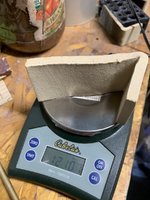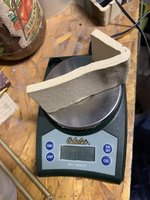mwar15
Omono
I could be wrong but,… I get asked “ is your pot fully vitrified.” I think people are worried about pots cracking from freeze/ thaw. I think the engineering and design of a pot play into this. So I calculated the absorption rate of the clay I use Unglazed.
I took a test fired to cone 6= 1162gr
Boiled for 2 hrs =1210gr
boiled weight-dry weight/dry weight*100
4.13%
I have been told my clay is fully vitrified. I haven’t had pots crack from winter freeze/thaw, but I live in a mild winter location.
something to think about as your pick clays.


I took a test fired to cone 6= 1162gr
Boiled for 2 hrs =1210gr
boiled weight-dry weight/dry weight*100
4.13%
I have been told my clay is fully vitrified. I haven’t had pots crack from winter freeze/thaw, but I live in a mild winter location.
something to think about as your pick clays.


